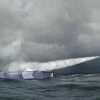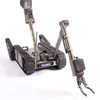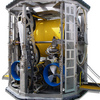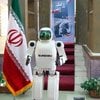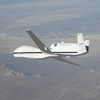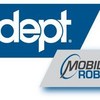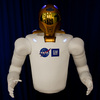Accuray Boeing Colin Angle Consumer Robotics CyberKnife CytoCare DARPA Education Financial Results Health Robotics Healthcare Robotics i.v.Station Industrial Robotics Industrial robotics International Space Station iRobot Liquid Robotics Lockheed Martin Medical Device Medical Robotics Medical robotics medical robotics Military Robotics Military robotics NASA Northrop Grumman Oceanography PackBot Remotely Operated Vehicle Research Robot Robotics ROV Schilling Robotics UAV Unmanned Aerial Vehicle unmanned aerial vehicle Unmanned aerial vehicle Unmanned Underwater Vehicle UUV
Piranha Unmanned Surface Vessel (USV) Hits The Waves
October 19, 2010
Zyvex Technologies announced that its Piranha USV, or unmanned surface vessel, has started a series of sea trials. The Piranha USV has a length of 54 feet and weighs less than 9,000 lbs. With a normal cruise speed of 25 knots (maximum cruising speed of over 45 knots) the Piranha is expected to offer on-station endurance of over 40 days.
The vessel is being developed with a number of missions in mind, including, search and rescue operations (SAR); anti piracy deployment; anti-submarine warfare (ASW); and other jobs as well.
The Piranha is built using Zyvex Technologies' Arovex carbon nanotube-reinforced carbon fiber prepreg. According to the firm, the lightweight Piranha offers 10 times the range, three times the payload, and a 75% increase in fuel efficiency compared to vessels built from heavier materials such as aluminium.
Click here to view a video showing the Piranha USV slicing through the waves of Puget Sound off the coast of Washington State.
Boeing Wins DARPA Development Contract
September 20, 2010
Boeing Defense, Space & Security recently signed an agreement with the U.S. Defense Advanced Research Projects Agency (DARPA) to develop and fly the SolarEagle unmanned aircraft for the Vulture II demonstration program. Under the terms of the $89 million contract, SolarEagle will make its first demonstration flight in 2014.
"SolarEagle is a uniquely configured, large unmanned aircraft designed to eventually remain on station at stratospheric altitudes for at least five years," explained Pat O'Neil, Boeing Phantom Works program manager for Vulture II. "That's a daunting task, but Boeing has a highly reliable solar-electric design that will meet the challenge in order to perform persistent communications, intelligence, surveillance, and reconnaissance missions from altitudes above 60,000 feet." The SolarEagle is designed to collect solar energy during the day, which is stored in fuel cells to power the unmanned aerial vehicle (UAV) through the night. The SolarEagle demonstrator will remain in the upper atmosphere for 30 days during the testing phase. Boeing also announced plans to develop a full-scale flight demonstrator, including maturation of the critical power system and structures technologies needed for the project.
"SolarEagle is a uniquely configured, large unmanned aircraft designed to eventually remain on station at stratospheric altitudes for at least five years," explained Pat O'Neil, Boeing Phantom Works program manager for Vulture II. "That's a daunting task, but Boeing has a highly reliable solar-electric design that will meet the challenge in order to perform persistent communications, intelligence, surveillance, and reconnaissance missions from altitudes above 60,000 feet." The SolarEagle is designed to collect solar energy during the day, which is stored in fuel cells to power the unmanned aerial vehicle (UAV) through the night. The SolarEagle demonstrator will remain in the upper atmosphere for 30 days during the testing phase. Boeing also announced plans to develop a full-scale flight demonstrator, including maturation of the critical power system and structures technologies needed for the project.
Evolution Robotics Announces Mint Retail Partners
September 20, 2010
Evolution Robotics, Inc., announced that the Mint Automatic Floor Cleaner is now available for purchase through select retail partners and online channels. This inaugural set of retailers includes such familiar names as Amazon.com, Frontgate, Hammacher Schlemmer, Home Shopping Network, RobotShop.com and SkyMall. According to the company, the Mint Automatic floor cleaner will be available in retail stores later this year.
Mint is designed exclusively for hard surface floor cleaning, dusting and "wet mopping" hard surface floors using cleaning cloths, such as Swiffer-brand Dry and Wet Cloths and other similar products.
"We are very excited to have a great group of retail partners assembled and selling Mint so customers can now experience the latest evolution in floor care," said Dr. Paolo Pirjanian, CEO of Evolution Robotics. "Early customer reviews have been overwhelmingly positive, reinforcing our belief that a hard surface floor cleaner that is automatic and easy to use serves an unmet need in the market."
Mint's square body shape allows the device to clean along edges of walls and into corners. According to the company, the device adapts to different home environments using a range of sensors including "first-of-their-kind" floor sensors to detect floor transitions and sensors for cleaning on slippery floors which allow Mint to adjust friction of the cleaning pad to maintain optimal traction with its wheels.
Schilling Robotics, DOF Subsea in ROV Deal
September 20, 2010
Schilling Robotics announced an order for two new 200hp UHD ROV systems from specialist subsea service company DOF Subsea. DOF Subsea is a specialist subsea service business that provides subsea construction, survey and inspection, repair and maintenance services.
The agreement between the companies also calls for upgrades to two previously delivered systems. The two older systems, originally delivered in 2006 will be upgraded to the advanced UHD Gen II design, providing enhanced capabilities and performance.
The agreement between the companies also calls for upgrades to two previously delivered systems. The two older systems, originally delivered in 2006 will be upgraded to the advanced UHD Gen II design, providing enhanced capabilities and performance.
Corindus Announces Results of Medical Device Study
September 20, 2010
Corindus Vascular Robotics announced the results of the first clinical study of the CorPath 200 System. The CorPath 200 is a medical device that offers interventional cardiologists complete PCI (percutaneous coronary intervention) procedure control from an interventional cockpit.
The trial - the first "in-human clinical study" of the CorPath 200 System - was conducted on eight patients to evaluate the safety and technical efficacy of the system in delivering and manipulating coronary guidewires and stent/balloon systems in PCI procedures.
The experiment demonstrated the CorPath 200 System's ability to deliver a guidewire and other angioplasty devices to a target lesion in a highly controlled manner.
The research was conducted at the Corbic Research Institute, Envigado, Colombia.
Corindus CEO David Handler was pleased with the results, stating that the ergonomic design of the CorPath 200 System improves the physician's ability to focus, enhances visualization, and offers precise robotic-assisted control.
"The first-in-human clinical study of the CorPath 200 System shows that for the first time a physician can execute an entire PCI procedure precisely and accurately without the pain, distraction and fatigue of manual procedures," he stated.
"We're extremely excited about the progress we continue to make in bringing the CorPath 200 System to market," Handler added. "We're even more excited about what this means for physicians and patients. We believe that a new robotic tool that improves procedure execution will ultimately help to further improve outcomes."
iRobot in Deal to Provide 125 PackBots
August 5, 2010
iRobot Corp. has announced a $20.3 million order from the Naval Sea Systems Command (NAVSEA).
The deal calls for iRobot to deliver 125 PackBot Man Transportable Robotic System (MTRS) robots, as well as spare parts. The company will also provide repairs if needed.
The MTRS is modeled after the iRobot 510 PackBot (see image), the company's battle-tested robot that is currently being used in both the Iraq and Afghanistan theaters of operation to conduct dangerous missions from safe distances.
The units have proven themselves adept at handling such dangerous tasks as identifying and neutralizing roadside bombs, car bombs and other improvised explosive devices (IEDs). The robot warriors are also being used for reconnaissance and other forward positioned missions.
According to Joe Dyer, president of iRobot's Government and Industrial Robots division, "Robots have consistently proven their worth on the battlefield. The iRobot PackBot is saving lives, and we are honored to be providing this technology to the military."
Schilling Nets Two More UHD ROV Orders
August 5, 2010
Schilling Robotics announced a new order for two UltraHeavy-Duty (UHD) Remotely Operated Vehicles (ROV), placed by the Australian subsea firm TS Marine. The systems are scheduled for delivery in the summer of 2010.
The UHD ROVs are able to operate at depths of approximately 4,000 meters or 13,000 feet.
The units will sport Schilling's XE (for eXtended Excursion) Tether Management System.
Northrop Grumman to Demonstrate Autonomous Aerial Refueling
July 4, 2010
Northrop Grumman has received a Defense Advanced Research Projects Agency (DARPA) contract award of $33million to demonstrate autonomous aerial refueling of a NASA Global Hawk unmanned aerial vehicle. The program will carry the designation KQ-X.
The plan calls for Northrop Grumman to retrofit two of the high altitude long endurance (HALE) UAVs, one aircraft pumping fuel into the other in flight through a hose-and-drogue aerial refueling system The aerial refueling engagement will be completely autonomous.
"Demonstrating the refueling of one UAV by another is a historic milestone," said Carl Johnson, vice president, Advanced Concepts for Northrop Grumman Aerospace Systems. "It adds aerial refueling to the list of capabilities that can be accomplished autonomously by Global Hawks; it opens the door to greatly expanded operational utility for UAVs; and, as a side benefit, it promises to increase the safety and reliability of aerial refueling between manned aircraft by reducing pilot workload."
Northrop Grumman will fly the Global Hawks from the NASA Dryden Flight Research Center at Edwards Air Force Base in California.
The plan calls for Northrop Grumman to retrofit two of the high altitude long endurance (HALE) UAVs, one aircraft pumping fuel into the other in flight through a hose-and-drogue aerial refueling system The aerial refueling engagement will be completely autonomous.
"Demonstrating the refueling of one UAV by another is a historic milestone," said Carl Johnson, vice president, Advanced Concepts for Northrop Grumman Aerospace Systems. "It adds aerial refueling to the list of capabilities that can be accomplished autonomously by Global Hawks; it opens the door to greatly expanded operational utility for UAVs; and, as a side benefit, it promises to increase the safety and reliability of aerial refueling between manned aircraft by reducing pilot workload."
Northrop Grumman will fly the Global Hawks from the NASA Dryden Flight Research Center at Edwards Air Force Base in California.
NASA Global Hawk Soars Over the Pacific
June 14, 2010
NASA announced earlier this month that the agency's unmanned Global Hawk aircraft, developed by Northrop Grumman, completed a series of four science flights over the Pacific Ocean back in April as part of the Global Hawk Pacific (GloPac) mission, a joint project between NASA and the National Oceanic and Atmospheric Administration (NOAA).
The GloPac mission flights were designed to collect data in the stratosphere. Fitted with 11 science instruments, Global Hawk acquired and transmitted data that has never before been accessible through either manned flights or satellites. Flights reached up to 65,000 feet where information was collected from the air as well as the water and polar ice below.
Flights ranged from north of the Arctic Circle, over polar ice, down to Hawaii near the equator. NASA Global Hawk completed 82.5 flight hours, with one particular flight lasting 28.6 hours, eight hours of which was spent north of Alaska over the polar ice.
Boeing in UAV Control Deal for U.S. Air Force
June 14, 2010
Boeing recently announced a three-year, $9.8 million US Air Force Research Lab contract to develop and demonstrate technologies designed to enable multiple small unmanned aerial vehicles (UAVs) to coordinate with each other and a manned airborne control station to more safely and effectively carry out intelligence, surveillance and reconnaissance missions.
The Foxhunt Multi-Small Unmanned Aerial System Cooperative Control Demonstration will leverage Boeing's networked systems expertise and technology advancements to directly support an emerging and challenging U.S. Air Force need.
According to Patrick Stokes of Boeing Research & Technology, "It's part of a grander vision outlined by the Air Force Research Laboratory to include the air launch, command-and-control and airborne recovery of unmanned aerial systems - all from an airborne mothership."
Stokes said the unmanned aerial systems are intended to be an extension of the manned mothership's sensor and weapon suites, improving situational awareness and intelligence, as well as surveillance and reconnaissance reach, allowing for safer stand-off distances.
Adept to Acquire MobileRobots
June 14, 2010
Adept Technology, Inc. , announced a deal to acquire New Hampshire-based, privately held MobileRobots Inc., a company that designs and develops autonomous robot and automated guided vehicle (AGV) technologies. According to an official press release, the terms of the acquisition involve approximately $1 million of cash at closing, plus 763,359 shares of Adept common stock which is subject to vesting conditions, and a contingent cash payment of up to $320,000 after one year for an estimated transaction value of $4.5 million.
Adept President and CEO, John Dulchinos explained the appeal of the acquisition. "With this acquisition, Adept strengthens its ability to develop and deliver highly flexible automation solutions aligned with the needs and demands of our target markets." MobileRobots solutions include individual robots in hospitals, factory floor AGV fleets, and more. The company's autonomous platforms are able to navigate in unstructured environments and provide comprehensive solutions and unmatched flexibility in delivering supplies, components and parts in complex and peopled environments. Jeanne Dietsch, CEO and Co-founder of MobileRobots was very pleased with the decision to join forces with Adept.
Adept President and CEO, John Dulchinos explained the appeal of the acquisition. "With this acquisition, Adept strengthens its ability to develop and deliver highly flexible automation solutions aligned with the needs and demands of our target markets." MobileRobots solutions include individual robots in hospitals, factory floor AGV fleets, and more. The company's autonomous platforms are able to navigate in unstructured environments and provide comprehensive solutions and unmatched flexibility in delivering supplies, components and parts in complex and peopled environments. Jeanne Dietsch, CEO and Co-founder of MobileRobots was very pleased with the decision to join forces with Adept.
Wind River Chosen for Radioactive Cleanup Robots
April 26, 2010
Wind River announced that VxWorks is the choice of the France-based Group of Robotic Intervention on Accidents (INTRA) for its new family of radioactive cleanup robots.
The robots are equipped with cameras and radioactivity sensors, and are designed to assess and clear radioactive accidents.
The control units in the robots and in the control center run VxWorks on an Intel Pentium 4 processor. According to a Wind River press release, the system needs a response time of less than 100 milliseconds for all the data and three channels of high-resolution video from the robot, including startup time, and the software must be highly deterministic to reliably handle all operations and give the operator real-time control.
The INTRA vehicles that are the first in line for VxWorks are the ERASE, EBENNE, and ERELT robotic vehicles.
· The External Reconnaissance, Assistance and Surveillance Robot (ERASE) is designed to inspect accident sites remotely. It can navigate rough terrain and be controlled from up to 10 kilometers away for up to ten hours.
· The Engin Benne, or EBENNE, is a dump truck equipped with cameras, lighting and a gamma detector to enable precise remote operation around the clock.
· The Teleoperated Relay Robot (ERELT) is fitted with a telescoping antenna and relays radio transmissions from the ERASE and EBENNE to a control desk, located a safe distance away.
Describing the choice of Wind River, Pascal Izydorczyk, Technical Operations Attache at INTRA Groupe said, "The INTRA Groupe robots are designed to operate under the most hostile conditions possible. A real-time response is necessary from the equipment when lives may be in danger and every second counts.
DARPA Loses Hypersonic Bird
April 26, 2010
The Defense Advanced Research Projects Agency (DARPA) is deploying its engineers to solve the riddle of why its Falcon Hypersonic Technology Vehicle 2 (HTV-2) stopped sending data just nine minutes into its mission.
According to the Agency, the Minotaur Lite launch system did what it was supposed to, namely deliver the HTV-2 glide vehicle to desired altitude, execute a series of energy management drills, break free of the clamshell fairing, and launch the HTV-2. However after approximately nine minutes, the vehicle experienced a terminal signal loss. According to the DARPA Web site, the Falcon program objectives are to develop and demonstrate hypersonic technologies that will enable prompt global reach missions. The technologies include high lift-to-drag techniques, high temperature materials, precision navigation, guidance, and control, communications through plasma, and an autonomous flight safety system.
According to the Agency, the Minotaur Lite launch system did what it was supposed to, namely deliver the HTV-2 glide vehicle to desired altitude, execute a series of energy management drills, break free of the clamshell fairing, and launch the HTV-2. However after approximately nine minutes, the vehicle experienced a terminal signal loss. According to the DARPA Web site, the Falcon program objectives are to develop and demonstrate hypersonic technologies that will enable prompt global reach missions. The technologies include high lift-to-drag techniques, high temperature materials, precision navigation, guidance, and control, communications through plasma, and an autonomous flight safety system.
ISS: Guess Who's Coming to Dinner?
April 26, 2010
NASA is making plans to send their Robonaut (or R2) robotic assistant to the International Space Station where it will become a permanent fixture, in preparation for eventually working alongside humans be it in space-based research activity or back on Earth in manufacturing settings.
R2, which was developed by NASA in tandem with General Motors (GM) weighs 300 pounds and consists of a head, torso and two arms and two hands. The soon to be ISS denizen will hitch a ride on the space shuttle Discovery as part of NASA's STS-133 mission, currently scheduled for September 16, 2010. This is scheduled to be the penultimate space shuttle mission.
R2 will be tested in microgravity and subjected to various radiation and electromagnetic interference environments.
According to John Olson, director of NASA's Exploration Systems Integration Office at NASA Headquarters in Washington, "This project exemplifies the promise that a future generation of robots can have both in space and on Earth, not as replacements for humans but as companions that can carry out key supporting roles. The combined potential of humans and robots is a perfect example of the sum equaling more than the parts.

